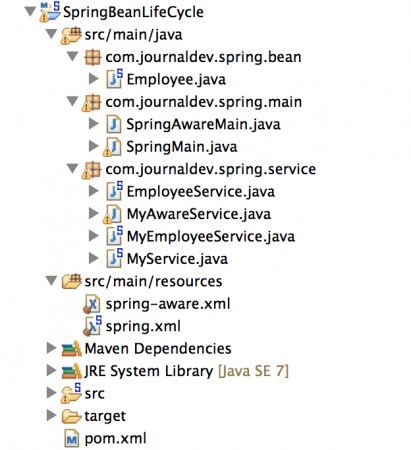今天我们将深入了解Spring Bean的生命周期。Spring Beans是任何Spring应用程序的最重要部分。Spring ApplicationContext负责初始化在spring bean配置文件中定义的Spring Beans。
Spring Bean生命周期
 Spring上下文还负责通过setter或构造方法或通过注入依赖关系在bean中进行依赖项注入,或通过spring自动装配。有时,我们希望在bean类中初始化资源,例如在任何客户端请求之前在初始化时创建数据库连接或验证第三方服务。Spring框架提供了多种方式,通过这些方式,我们可以在Spring Bean生命周期中提供后初始化和销毁前的方法。
Spring上下文还负责通过setter或构造方法或通过注入依赖关系在bean中进行依赖项注入,或通过spring自动装配。有时,我们希望在bean类中初始化资源,例如在任何客户端请求之前在初始化时创建数据库连接或验证第三方服务。Spring框架提供了多种方式,通过这些方式,我们可以在Spring Bean生命周期中提供后初始化和销毁前的方法。
- 通过实现InitializingBean和DisposableBean接口 – 这两个接口声明了一个方法,我们可以在bean中初始化/关闭资源。对于后初始化,我们可以实现
InitializingBean接口并提供afterPropertiesSet()方法的实现。对于预销毁,我们可以实现DisposableBean接口并提供destroy()方法的实现。这些方法是回调方法,类似于servlet监听器的实现。这种方法简单易用,但不推荐,因为它将在我们的bean实现中与Spring框架产生紧密耦合。 - 为在Spring bean配置文件中的bean提供init-method和destroy-method属性值。这是推荐的方法,因为它没有直接依赖于Spring框架,我们可以创建自己的方法。
请注意,post-init和pre-destroy方法都不应该有参数,但它们可以抛出异常。我们还需要从Spring应用程序上下文中获取bean实例,以便调用这些方法。
Spring Bean生命周期 – @PostConstruct,@PreDestroy注解
Spring框架还支持@PostConstruct和@PreDestroy注解来定义后初始化和销毁前方法。这些注解是javax.annotation包的一部分。但是要使这些注解起作用,我们需要配置我们的Spring应用程序来查找注解。我们可以通过定义org.springframework.context.annotation.CommonAnnotationBeanPostProcessor类型的bean或在Spring bean配置文件中使用context:annotation-config元素来实现这一点。让我们编写一个简单的Spring应用程序来展示上述配置用于Spring bean生命周期管理。在Spring Tool Suite中创建一个Spring Maven项目,最终项目将看起来像下面的图片。
Spring Bean生命周期 – Maven依赖项
我们不需要包含任何额外的依赖项来配置Spring bean生命周期方法,我们的pom.xml文件与任何其他标准的Spring Maven项目一样。
<project xmlns="https://maven.apache.org/POM/4.0.0" xmlns:xsi="https://www.w3.org/2001/XMLSchema-instance" xsi:schemaLocation="https://maven.apache.org/POM/4.0.0 https://maven.apache.org/xsd/maven-4.0.0.xsd">
<modelVersion>4.0.0</modelVersion>
<groupId>org.springframework.samples</groupId>
<artifactId>SpringBeanLifeCycle</artifactId>
<version>0.0.1-SNAPSHOT</version>
<properties>
<!-- Generic properties -->
<java.version>1.7</java.version>
<project.build.sourceEncoding>UTF-8</project.build.sourceEncoding>
<project.reporting.outputEncoding>UTF-8</project.reporting.outputEncoding>
<!-- Spring -->
<spring-framework.version>4.0.2.RELEASE</spring-framework.version>
<!-- Logging -->
<logback.version>1.0.13</logback.version>
<slf4j.version>1.7.5</slf4j.version>
</properties>
<dependencies>
<!-- Spring and Transactions -->
<dependency>
<groupId>org.springframework</groupId>
<artifactId>spring-context</artifactId>
<version>${spring-framework.version}</version>
</dependency>
<dependency>
<groupId>org.springframework</groupId>
<artifactId>spring-tx</artifactId>
<version>${spring-framework.version}</version>
</dependency>
<!-- Logging with SLF4J & LogBack -->
<dependency>
<groupId>org.slf4j</groupId>
<artifactId>slf4j-api</artifactId>
<version>${slf4j.version}</version>
<scope>compile</scope>
</dependency>
<dependency>
<groupId>ch.qos.logback</groupId>
<artifactId>logback-classic</artifactId>
<version>${logback.version}</version>
<scope>runtime</scope>
</dependency>
</dependencies>
</project>
Spring Bean生命周期 – 模型类
让我们创建一个简单的Java Bean类,该类将在服务类中使用。
package com.journaldev.spring.bean;
public class Employee {
private String name;
public String getName() {
return name;
}
public void setName(String name) {
this.name = name;
}
}
Spring Bean生命周期 – InitializingBean,DisposableBean
让我们创建一个服务类,在该类中我们将实现用于后初始化和预销毁方法的两个接口。
package com.journaldev.spring.service;
import org.springframework.beans.factory.DisposableBean;
import org.springframework.beans.factory.InitializingBean;
import com.journaldev.spring.bean.Employee;
public class EmployeeService implements InitializingBean, DisposableBean{
private Employee employee;
public Employee getEmployee() {
return employee;
}
public void setEmployee(Employee employee) {
this.employee = employee;
}
public EmployeeService(){
System.out.println("EmployeeService no-args constructor called");
}
@Override
public void destroy() throws Exception {
System.out.println("EmployeeService Closing resources");
}
@Override
public void afterPropertiesSet() throws Exception {
System.out.println("EmployeeService initializing to dummy value");
if(employee.getName() == null){
employee.setName("Pankaj");
}
}
}
Spring Bean生命周期 – 自定义后初始化,预销毁
由于我们不希望我们的服务直接依赖于Spring框架,让我们创建另一种形式的Employee Service类,在这个类中,我们将拥有后初始化和预销毁的Spring生命周期方法,并将它们配置在Spring Bean配置文件中。
package com.journaldev.spring.service;
import com.journaldev.spring.bean.Employee;
public class MyEmployeeService{
private Employee employee;
public Employee getEmployee() {
return employee;
}
public void setEmployee(Employee employee) {
this.employee = employee;
}
public MyEmployeeService(){
System.out.println("MyEmployeeService no-args constructor called");
}
//预销毁方法
public void destroy() throws Exception {
System.out.println("MyEmployeeService Closing resources");
}
//后初始化方法
public void init() throws Exception {
System.out.println("MyEmployeeService initializing to dummy value");
if(employee.getName() == null){
employee.setName("Pankaj");
}
}
}
我们将稍后查看Spring Bean配置文件。在那之前,让我们创建另一个服务类,该类将使用@PostConstruct和@PreDestroy注解。
Spring Bean生命周期 – @PostConstruct, @PreDestroy
下面是一个将被配置为Spring Bean的简单类,我们在这里使用@PostConstruct和@PreDestroy注解来进行后初始化和前销毁方法。
package com.journaldev.spring.service;
import javax.annotation.PostConstruct;
import javax.annotation.PreDestroy;
public class MyService {
@PostConstruct
public void init(){
System.out.println("MyService init method called");
}
public MyService(){
System.out.println("MyService no-args constructor called");
}
@PreDestroy
public void destory(){
System.out.println("MyService destroy method called");
}
}
Spring Bean生命周期 – 配置文件
让我们看看如何在Spring上下文文件中配置我们的bean。
<?xml version="1.0" encoding="UTF-8"?>
<beans xmlns="https://www.springframework.org/schema/beans"
xmlns:xsi="https://www.w3.org/2001/XMLSchema-instance"
xsi:schemaLocation="https://www.springframework.org/schema/beans https://www.springframework.org/schema/beans/spring-beans.xsd">
<!-- Not initializing employee name variable-->
<bean name="employee" class="com.journaldev.spring.bean.Employee" />
<bean name="employeeService" class="com.journaldev.spring.service.EmployeeService">
<property name="employee" ref="employee"></property>
</bean>
<bean name="myEmployeeService" class="com.journaldev.spring.service.MyEmployeeService"
init-method="init" destroy-method="destroy">
<property name="employee" ref="employee"></property>
</bean>
<!-- initializing CommonAnnotationBeanPostProcessor is same as context:annotation-config -->
<bean class="org.springframework.context.annotation.CommonAnnotationBeanPostProcessor" />
<bean name="myService" class="com.journaldev.spring.service.MyService" />
</beans>
请注意,我没有在bean定义中初始化雇员名称。由于EmployeeService正在使用接口,我们在这里不需要任何特殊的配置。对于MyEmployeeService bean,我们使用init-method和destroy-method属性来告诉Spring框架执行我们的自定义方法。MyService bean配置没有任何特殊之处,但正如您所看到的,我正在为此启用基于注解的配置。我们的应用程序已准备好,让我们编写一个测试程序,看看如何执行不同的方法。
Spring Bean生命周期 – 测试程序
package com.journaldev.spring.main;
import org.springframework.context.support.ClassPathXmlApplicationContext;
import com.journaldev.spring.service.EmployeeService;
import com.journaldev.spring.service.MyEmployeeService;
public class SpringMain {
public static void main(String[] args) {
ClassPathXmlApplicationContext ctx = new ClassPathXmlApplicationContext("spring.xml");
System.out.println("Spring Context initialized");
//MyEmployeeService service = ctx.getBean("myEmployeeService", MyEmployeeService.class);
EmployeeService service = ctx.getBean("employeeService", EmployeeService.class);
System.out.println("Bean retrieved from Spring Context");
System.out.println("Employee Name="+service.getEmployee().getName());
ctx.close();
System.out.println("Spring Context Closed");
}
}
当我们运行上述测试程序时,我们得到以下输出。
Apr 01, 2014 10:50:50 PM org.springframework.context.support.ClassPathXmlApplicationContext prepareRefresh
INFO: Refreshing org.springframework.context.support.ClassPathXmlApplicationContext@c1b9b03: startup date [Tue Apr 01 22:50:50 PDT 2014]; root of context hierarchy
Apr 01, 2014 10:50:50 PM org.springframework.beans.factory.xml.XmlBeanDefinitionReader loadBeanDefinitions
INFO: Loading XML bean definitions from class path resource [spring.xml]
EmployeeService no-args constructor called
EmployeeService initializing to dummy value
MyEmployeeService no-args constructor called
MyEmployeeService initializing to dummy value
MyService no-args constructor called
MyService init method called
Spring Context initialized
Bean retrieved from Spring Context
Employee Name=Pankaj
Apr 01, 2014 10:50:50 PM org.springframework.context.support.ClassPathXmlApplicationContext doClose
INFO: Closing org.springframework.context.support.ClassPathXmlApplicationContext@c1b9b03: startup date [Tue Apr 01 22:50:50 PDT 2014]; root of context hierarchy
MyService destroy method called
MyEmployeeService Closing resources
EmployeeService Closing resources
Spring Context Closed
Spring Bean生命周期重要点:
- 从控制台输出可以清楚地看到,Spring Context首先使用无参数构造函数来初始化bean对象,然后调用post-init方法。
- bean的初始化顺序与其在spring bean配置文件中定义的顺序相同。
- 只有当所有spring bean都通过post-init方法正确初始化后,才会返回上下文。
- 员工姓名打印为“Pankaj”,因为它是在post-init方法中初始化的。
- 当上下文关闭时,bean将以初始化顺序的相反顺序销毁,即以LIFO(后进先出)顺序。
您可以取消注释代码以获取类型为MyEmployeeService的bean,并确认输出将类似并遵循上述所有要点。
Spring Aware接口
有时我们需要在我们的bean中使用Spring Framework对象来执行一些操作,例如读取ServletConfig和ServletContext参数,或者了解由ApplicationContext加载的bean定义。这就是为什么Spring框架提供了一堆*Aware接口,我们可以在我们的bean类中实现。`org.springframework.beans.factory.Aware`是所有这些Aware接口的根标记接口。所有*Aware接口都是Aware的子接口,并声明一个单一的setter方法,由bean实现。然后Spring上下文使用基于setter的依赖注入将相应的对象注入到bean中,并使其可供我们使用。Spring Aware接口类似于带有回调方法的servlet监听器,并实现观察者设计模式。一些重要的Aware接口包括:
- ApplicationContextAware – 用于注入ApplicationContext对象,示例用法是获取bean定义名称的数组。
- BeanFactoryAware – 用于注入BeanFactory对象,示例用法是检查bean的作用域。
- BeanNameAware – 用于了解配置文件中定义的bean名称。
- ResourceLoaderAware – 用于注入 ResourceLoader 对象,示例用法是获取类路径中文件的输入流。
- ServletContextAware – 用于在 MVC 应用程序中注入 ServletContext 对象,示例用法是读取上下文参数和属性。
- ServletConfigAware – 用于在 MVC 应用程序中注入 ServletConfig 对象,示例用法是获取 Servlet 配置参数。
让我们通过在一个类中实现其中几个 Aware 接口,并将其配置为 Spring Bean,来看看这些 Aware 接口的使用情况。
package com.journaldev.spring.service;
import java.util.Arrays;
import org.springframework.beans.BeansException;
import org.springframework.beans.factory.BeanClassLoaderAware;
import org.springframework.beans.factory.BeanFactory;
import org.springframework.beans.factory.BeanFactoryAware;
import org.springframework.beans.factory.BeanNameAware;
import org.springframework.context.ApplicationContext;
import org.springframework.context.ApplicationContextAware;
import org.springframework.context.ApplicationEventPublisher;
import org.springframework.context.ApplicationEventPublisherAware;
import org.springframework.context.EnvironmentAware;
import org.springframework.context.ResourceLoaderAware;
import org.springframework.context.annotation.ImportAware;
import org.springframework.core.env.Environment;
import org.springframework.core.io.Resource;
import org.springframework.core.io.ResourceLoader;
import org.springframework.core.type.AnnotationMetadata;
public class MyAwareService implements ApplicationContextAware,
ApplicationEventPublisherAware, BeanClassLoaderAware, BeanFactoryAware,
BeanNameAware, EnvironmentAware, ImportAware, ResourceLoaderAware {
@Override
public void setApplicationContext(ApplicationContext ctx)
throws BeansException {
System.out.println("setApplicationContext called");
System.out.println("setApplicationContext:: Bean Definition Names="
+ Arrays.toString(ctx.getBeanDefinitionNames()));
}
@Override
public void setBeanName(String beanName) {
System.out.println("setBeanName called");
System.out.println("setBeanName:: Bean Name defined in context="
+ beanName);
}
@Override
public void setBeanClassLoader(ClassLoader classLoader) {
System.out.println("setBeanClassLoader called");
System.out.println("setBeanClassLoader:: ClassLoader Name="
+ classLoader.getClass().getName());
}
@Override
public void setResourceLoader(ResourceLoader resourceLoader) {
System.out.println("setResourceLoader called");
Resource resource = resourceLoader.getResource("classpath:spring.xml");
System.out.println("setResourceLoader:: Resource File Name="
+ resource.getFilename());
}
@Override
public void setImportMetadata(AnnotationMetadata annotationMetadata) {
System.out.println("setImportMetadata called");
}
@Override
public void setEnvironment(Environment env) {
System.out.println("setEnvironment called");
}
@Override
public void setBeanFactory(BeanFactory beanFactory) throws BeansException {
System.out.println("setBeanFactory called");
System.out.println("setBeanFactory:: employee bean singleton="
+ beanFactory.isSingleton("employee"));
}
@Override
public void setApplicationEventPublisher(
ApplicationEventPublisher applicationEventPublisher) {
System.out.println("setApplicationEventPublisher called");
}
}
Spring *Aware 示例配置文件
非常简单的 Spring Bean 配置文件。
<?xml version="1.0" encoding="UTF-8"?>
<beans xmlns="https://www.springframework.org/schema/beans"
xmlns:xsi="https://www.w3.org/2001/XMLSchema-instance"
xsi:schemaLocation="https://www.springframework.org/schema/beans https://www.springframework.org/schema/beans/spring-beans.xsd">
<bean name="employee" class="com.journaldev.spring.bean.Employee" />
<bean name="myAwareService" class="com.journaldev.spring.service.MyAwareService" />
</beans>
Spring *Aware 测试程序
package com.journaldev.spring.main;
import org.springframework.context.support.ClassPathXmlApplicationContext;
import com.journaldev.spring.service.MyAwareService;
public class SpringAwareMain {
public static void main(String[] args) {
ClassPathXmlApplicationContext ctx = new ClassPathXmlApplicationContext("spring-aware.xml");
ctx.getBean("myAwareService", MyAwareService.class);
ctx.close();
}
}
现在当我们执行以上类时,我们会得到以下输出。
Apr 01, 2014 11:27:05 PM org.springframework.context.support.ClassPathXmlApplicationContext prepareRefresh
INFO: Refreshing org.springframework.context.support.ClassPathXmlApplicationContext@60a2f435: startup date [Tue Apr 01 23:27:05 PDT 2014]; root of context hierarchy
Apr 01, 2014 11:27:05 PM org.springframework.beans.factory.xml.XmlBeanDefinitionReader loadBeanDefinitions
INFO: Loading XML bean definitions from class path resource [spring-aware.xml]
setBeanName called
setBeanName:: Bean Name defined in context=myAwareService
setBeanClassLoader called
setBeanClassLoader:: ClassLoader Name=sun.misc.Launcher$AppClassLoader
setBeanFactory called
setBeanFactory:: employee bean singleton=true
setEnvironment called
setResourceLoader called
setResourceLoader:: Resource File Name=spring.xml
setApplicationEventPublisher called
setApplicationContext called
setApplicationContext:: Bean Definition Names=[employee, myAwareService]
Apr 01, 2014 11:27:05 PM org.springframework.context.support.ClassPathXmlApplicationContext doClose
INFO: Closing org.springframework.context.support.ClassPathXmlApplicationContext@60a2f435: startup date [Tue Apr 01 23:27:05 PDT 2014]; root of context hierarchy
测试程序的控制台输出很容易理解,我不会详细说明。关于 Spring Bean 生命周期方法和将框架特定对象注入到 Spring Bean 中,就介绍到这里。请从下面的链接下载示例项目并进行分析以了解更多信息。
Source:
https://www.digitalocean.com/community/tutorials/spring-bean-life-cycle













